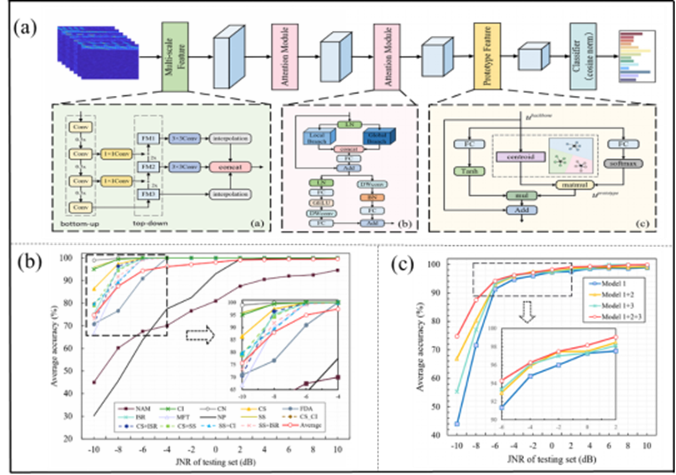The identification of radar interference in electromagnetic environments has always been a significant challenge for radar systems in communications, aeronautics, and astronautics. In the ever-changing electromagnetic landscape, various interference signals interweave and superimpose, affecting the detection performance and system stability of radars. Traditional identification methods are constrained by the issues of small sample sizes and data imbalance, leading to insufficient generalization capabilities and difficulties in effectively classifying interference signals. Addressing this issue, Professor Guo Zhongyi from our school has led a team to propose a novel interference identification method based on prototype features, which enhances the accuracy of identification under conditions of limited samples and improves the anti-jamming capability of radar systems. This approach provides a new technical perspective for radar interference identification in complex environments. The related research findings, titled "Prototype Features Driven High-Performance Few-Shot Radar Active Jamming Recognition," have been published in the IEEE Transactions on Radar Systems.
Paper Title: Prototype Features Driven High-Performance Few-Shot Radar Active Jamming Recognition
Authors: Hongping Zhou; Xiaomin Cai; Peng Peng; Zhongyi Guo
Paper Link: https://ieeexplore.ieee.org/document/10891039

Figure 1: Few-Shot Radar Interference Recognition Based on Prototype Features; (a) CNN model ; (b) Average recognition accuracy of jamming with 3% of the samples; (c) Recognition results of each module with 3% of the samples
Abstract:Accurate identification of jamming is the premise of effective work of radar anti-jamming systems. As the electromagnetic environment becomes increasingly complex, radar detection faces not only the issue of insufficient training samples but also the challenge of imbalanced jamming samples. To solve this problem, this article proposes a few-shot recognition method of radar active jamming guided by prototype features. In this method, a pyramid structure is used to construct feature maps at different levels to integrate low-level features and highlevel semantic features, so as to retain the information of the time–frequency images of the jamming signal to the maximum extent. Meanwhile, a differentiation information attention module is introduced to capture the global and local information of the feature maps and enhance the signal perception ability of the model. Finally, we propose a prototype feature extraction and fusion module to learn the prototype features of various samples and fuse them with backbone features. In view of the uneven data of the training set, the imbalanced coefficient is proposed to improve the recognition accuracy of the few-shot jamming signal in a complex electromagnetic environment. The experimental results on the jamming simulation dataset show that the proposed model has good recognition accuracy and robustness, and can handle imbalanced jamming samples. When the jamming-to-noise ratio (JNR) exceeds 2 dB, the average recognition accuracy of jamming can reach 99%. In the case of low JNR and sample imbalance, the proposed structure can effectively identify multiple small classes of jamming.
The IEEE Transactions on Radar Systems officially began accepting submissions in October 2022 and has emerged as a significant international journal in the field of radar systems. It is sponsored and published by the IEEE (Institute of Electrical and Electronics Engineers), the world's largest technical professional organization. As an important academic journal in the radar domain, the IEEE Transactions on Radar Systems is recommended by the CCF (China Computer Federation) as a Category B international academic journal.
 TOP
TOP